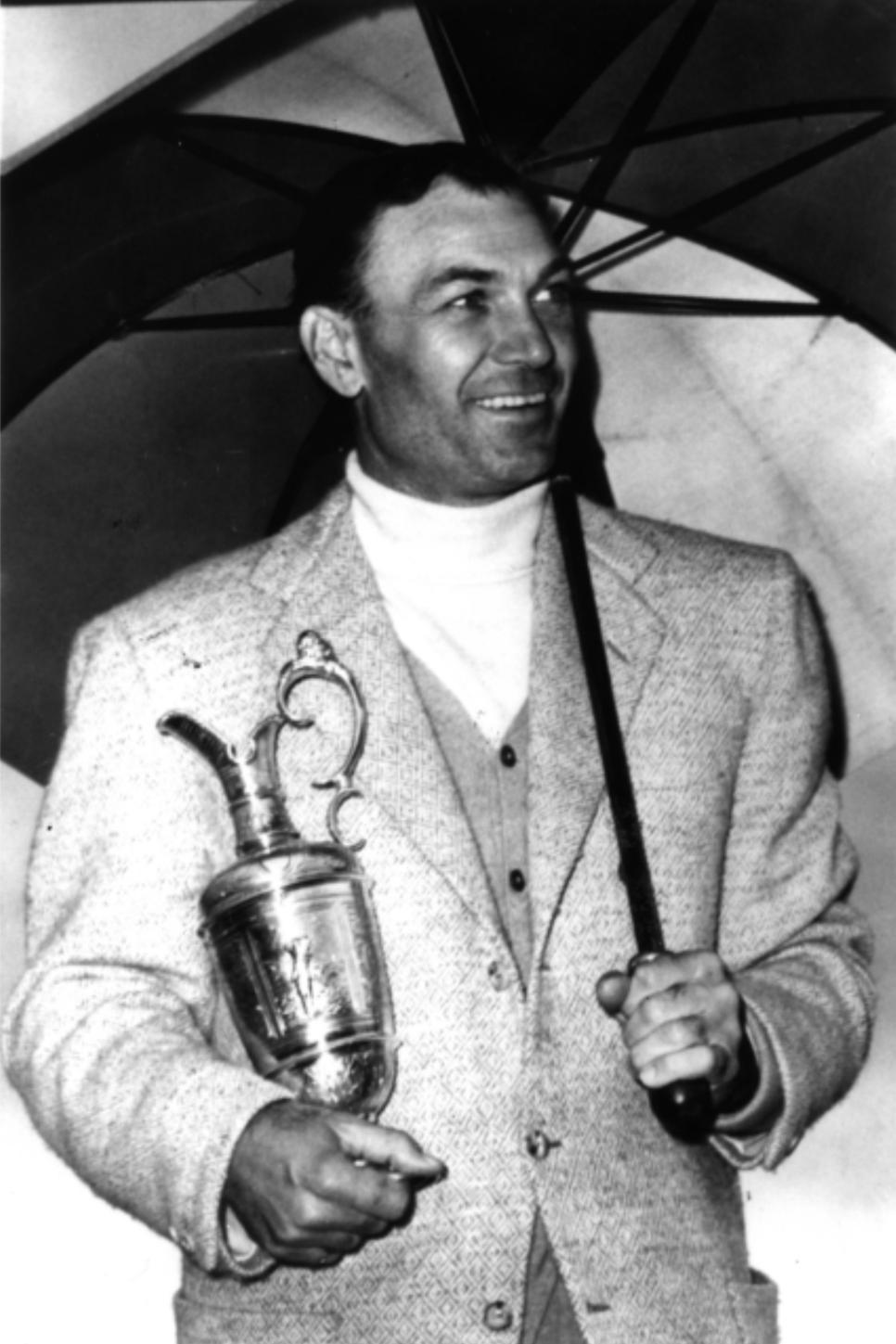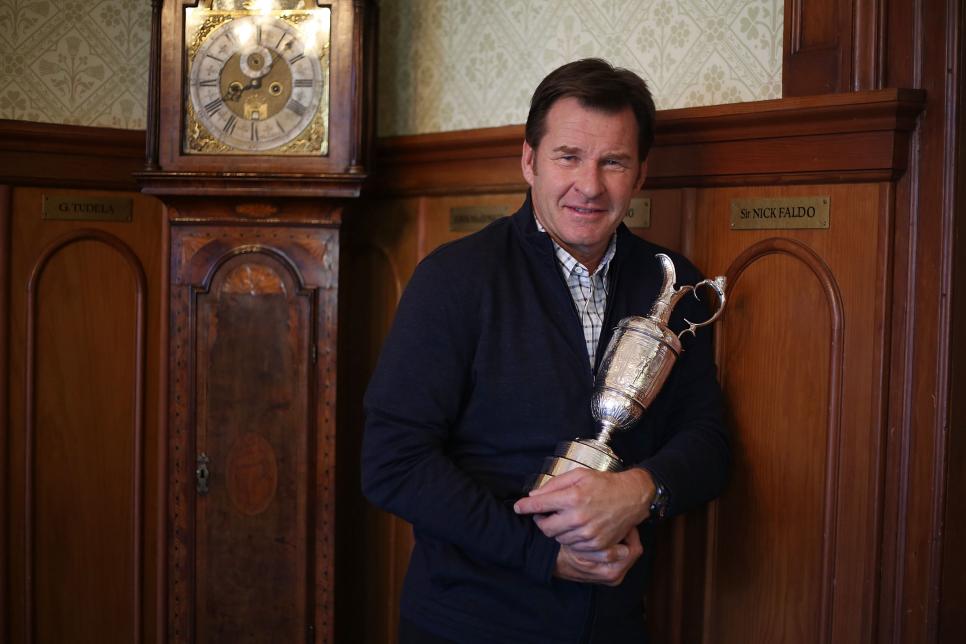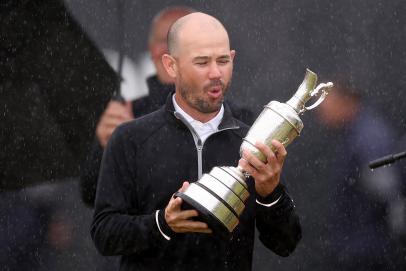The claret jug over 152 years: Triumphs, dents, hijinks and lots of drinking – Australian Golf Digest

- by Admin
- July 12, 2024

The claret jug, the coveted prize presented to the winner of the British Open, has seen quite a bit of the world—and probably parts of it many folks might not want to see. It’s been on a bar crawl in Minneapolis, toasted at a Hooters restaurant in Texas, reportedly got roughed up in an Australian rules football game Down Under, hit a McDonald’s drive-thru and, um, even slept next to a very appreciative caretaker.
It has also been the receptacle for countless beverages, most of an alcoholic consistency, but that is exactly what the thing was made for if you stop and think about it for three seconds.
MORE: The British Open Championship by the numbers
Ben Hogan with the claret jug after his 1953 win.
Getty Images
Officially named the Golf Champion Trophy, the claret jug at its most basic is really just a wine decanter. When it was created in 1872, it was truly the perfect prize for the winner of the Champion Golfer of the Year. Not that it isn’t a very special wine decanter, composed of 92.5 percent sterling silver. The organizers of the championship at Prestwick Club, which hosted the first 12 championships, found themselves in 1871 without a prize to award to their champion because Tom Morris Jr. absconded with the previous one, The Challenge Belt, after winning the championship three years in a row. Thus, having no trophy, organizers decided that there would be no tournament that year, either.
With the resumption of the championship in 1872, it was decided that the tournament should be rotated among Prestwick, the Royal & Ancient Golf Club of St. Andrews and the Honourable Company of Edinburgh Golfers (then based at Musselburgh and now at Murifield). The three clubs contributed 10 pounds each toward the commission of a new trophy, a claret jug of 21¾ inches in height, 5½ inches in diameter and weighing 5½ pounds. Tom Morris Jr. won the title yet again but not the jug; it hadn’t been completed in time. Tom Kidd, who won at St. Andrews in 1873, actually was the first recipient of the original claret jug.
Organizers chose a wine decanter as their new symbol of golf supremacy given the British affinity for food and drink—mostly drink. One of the more popular choices among the upper class was a dry red wine known as claret, and considering that wine was among the more appropriate awards of the day for contests of sports or wagering, it seemed only logical that a receptacle for such plunder should be not only proper but welcome.
More from Golf Digest  Golf Digest Logo British Open 2024: The 5 holes that will decide who wins at Royal Troon
Golf Digest Logo British Open 2024: The 5 holes that will decide who wins at Royal Troon  Media handling How Brian Harman—aka the ‘Butcher of Hoylake’—beat the British tabloids
Media handling How Brian Harman—aka the ‘Butcher of Hoylake’—beat the British tabloids  No Further Questions Rory McIlroy’s media blowoff reignites a debate about obligation in the face of frustration
No Further Questions Rory McIlroy’s media blowoff reignites a debate about obligation in the face of frustration
With the exception of a strange mix-up more than 40 years ago, no winner has held that original since 1926, when Bobby Jones won his second title. In time for the ’27 championship, also won by Jones, the R&A (which by then had assumed control of the championship) commissioned the creation of a replica, deeming the real one too valuable to have bandied about the globe—or, in this case, regularly crossing the Atlantic as it did for most of the 1920s with Americans Jones, Walter Hagen, Jock Hutchison and Jim Barnes winning.
Doubtful the timing of this is a coincidence. In November 1925, the original U.S. Amateur prize, the Havemayer Trophy, which was in Jones’ possession and on display at East Lake Golf Club in Atlanta, was lost in a fire. Then in ’26, Walter Hagen claimed to have lost the Wanamaker Trophy in a New York taxicab, but the enormous PGA Championship memento turned up four years later in a Detroit warehouse that happened to be owned by the Walter Hagen Company.

Three-time Open champion Sir Nick Faldo poses with the claret jub in the locker room at St. Andrews in 2015.
Jeremy Sutton-Hibbert/R&A
Coincidentally, Hagen would be the possessor of the full-scale replica claret jug in 1928 and ’29. Edward, Prince of Wales presented the new rendition to Hagen in ’28 at Royal St. George’s, and when The Haig came back the following year to Muirfield, the free-spirited champion couldn’t hide the two-inch dent in the side. He allegedly struck it with a club while showing off—after being overserved.
Since then, it is believed that the R&A has created three more “official” replicas, including one for the World Golf Hall of Fame, while the grandaddy is in safe keeping and on display in the front hall of the R&A along with The Amateur trophy and The Championship Belt.
Good thing. Because its immediate offspring has gotten around and endured numerous injuries. The most serious probably occurred in 1996 when Tom Lehman’s daughter Holly decided to play dolls with it and somehow bent the jug at the base to a 45-degree angle. Lehman had it repaired by a silversmith. Rewind the reel to 1987 when Nick Faldo won his first Open title. Usually, the Champion Golfer of the Year takes ownership of the claret jug until the following year, but Faldo immediately had to give it back to the R&A for repairs. It seems the previous holder, Greg Norman, had allowed it to sustain several dents, including one rather large one rumored to be the result of its participation in or proximity to a game of Australian rules football.
Faldo was much gentler with it when he finally got it back. He told a BBC reporter that he didn’t let it out of his sight, and that meant bedtime, too. “When you wake up in the morning,” he said, “you can put your hand out in the dark and say, ‘Bloody hell, it’s the claret jug.’” At least there was no spooning. That we know of.
How did the claret jug end up at a Hooters in McKinney, Texas? Don’t blame John Daly, who has a sponsorship deal with the restaurant chain. Todd Hamilton stopped at Hooters with friends after a casual round of golf a week after his 2004 victory, and Hamilton thought it would be fun to take a swig of champagne from the claret jug with his order of wings. This was after downing several beers. Realizing he hadn’t had a drink from the jug, he retrieved the trophy from the trunk of his car, and five hours later he’d had more than a swig. “I don’t think anybody in there knew what it was; they probably thought it was some kind of NASCAR trophy,” he said.

Tom Lehman hugs the claret jug in 1996.
R&A Championships
Immediately upon winning at St. Andrews in 1995, Daly is said to have driven across the Tay Bridge to Dundee to celebrate by stopping at a McDonald’s. The following year, in Lehman’s possession, it got bent by his daughter, as previously mentioned, and then went on a bender one July night in 1997. Lehman had taken the claret jug to a charity dinner in Minneapolis, and afterward, as Lehman signed autographs, the trophy got passed along to Lehman’s wife, Melissa, who gave it to Alissa Herron. The sister of tour player Tim Herron, Alissa worked for Jim Lehman, who served as his brother’s agent.
Alissa Lehman and two friends left the charity event and embarked on visits to a couple of local bars. A man named Freddie Manton, manager at Brit’s Pub in Minneapolis, called police when the women jokingly said they had stolen the trophy and wanted to drink from it. Police called Tom Lehman at 2 a.m., and he cleared the women when he was told one of them was Alissa Herron. “This morning, I thought Jim was going to fire me,” she told a reporter, “but thankfully they did find some humor in it.”
There is only one player alive who not only has held the original claret jug but took it home with him. That would be Tom Watson. No one has been able—or is willing—to explain the circumstances that led to Watson being awarded the authentic grandaddy in 1982 at Royal Troon, site of the upcoming British Open. He didn’t know it at the time, but Watson figured it out, accidentally, when he noticed the amount of wear under the lip where champions’ names had been added after no more room remained on the front panel. There’s no mystery to how that wear occurs, but the original in his possession didn’t have as much as the replica he’d held after previous wins. Apparently, quaffing from the jug is a more modern phenomenon. The names on the original were worn but a bit more legible.

Tom Watson and the claret jug after he won in 1982.
R&A Championships
Now, he never would have noticed that had he not bent the lip by knocking the claret jug off his desk with a 6-iron while making practice swings in his Kansas City office.
“I looked at it, and there was no crease to it. There was no breakage,” Watson, 74, explained. “And so I decided, because silver’s so soft, to repair it myself. I wrapped it in felt and bent it back up with a vise. I had a backup plan. I had a good silversmith in Kansas City who could repair it if my efforts failed and created a crack there. But I managed to get it in its original position without a crack. No one knew the difference.”
Watson successfully defended his title in 1983 at Royal Birkdale in Southport, England. This time, he received the replica. He saw that the names under the lip were just about gone.
More from Golf Digest  Golf Digest Logo Links Golf Interactive: What shot should you play?
Golf Digest Logo Links Golf Interactive: What shot should you play?  British Open FAQ British Open 2024: Everything you need to know about this year’s major at Royal Troon
British Open FAQ British Open 2024: Everything you need to know about this year’s major at Royal Troon  Ranking British Open picks 2024: The 13 best bets to win at Royal Troon
Ranking British Open picks 2024: The 13 best bets to win at Royal Troon
This article was originally published on golfdigest.com
The Latest News
-
November 15, 2024Nick Kyrgios set to make long-awaited return to tennis as comeback date revealed
-
November 15, 2024List wins elusive DP World Tour card, Barron loses his
-
November 15, 2024India great warns ‘the king is back in his territory’ as struggling Virat Kohli returns for fifth tour
-
November 15, 2024‘Adaptable’ Murphy spins out WA to put Vics in control | cricket.com.au
-
November 15, 2024Nick Kyrgios: Australian tennis star confirms return to ATP Tour at Brisbane International in December





